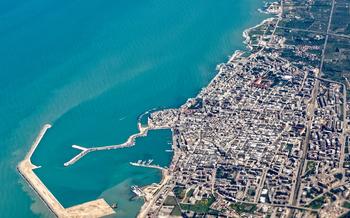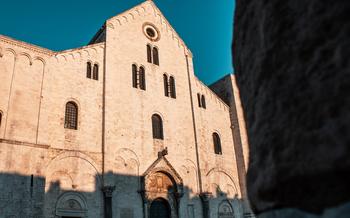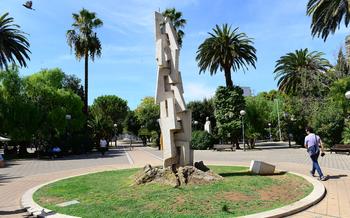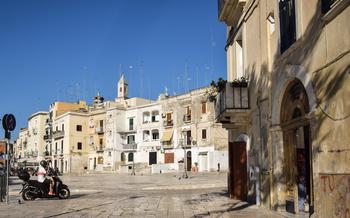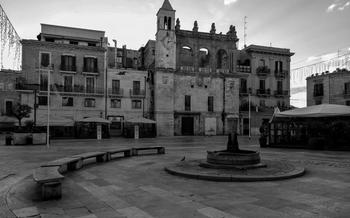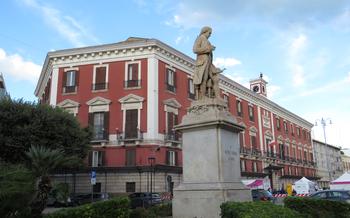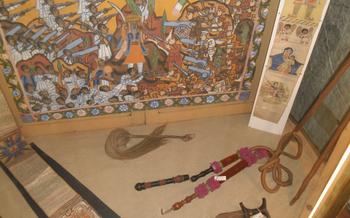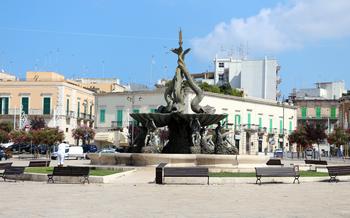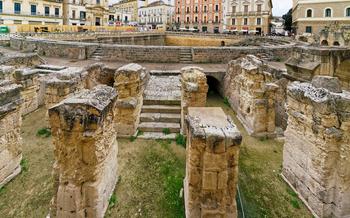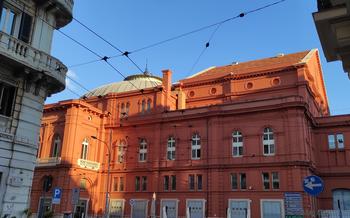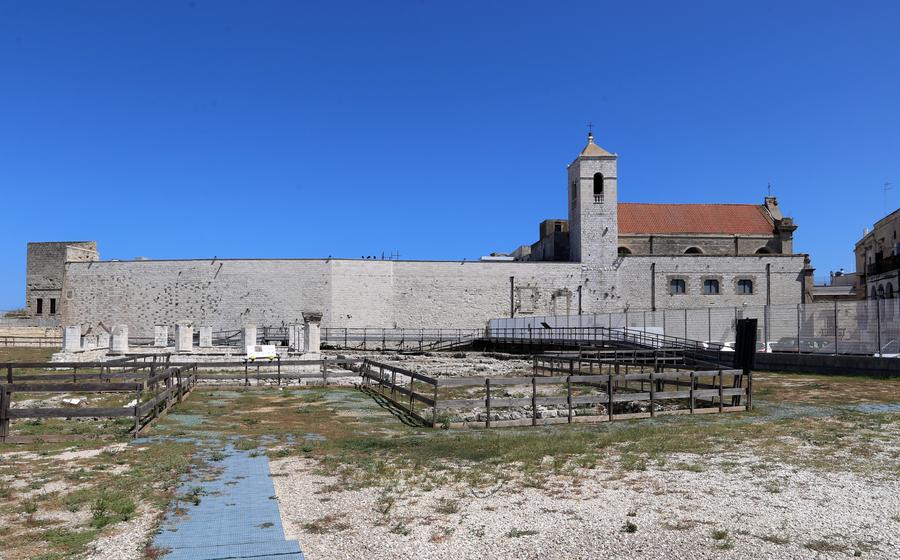
Museo Archeologico di Bari
- Introduction
- Location and Accessibility
- Operating Hours and Admission Fees
- Pre-Visit Preparations
- Museo Archeologico di Bari Highlights
- The Daune Collection
- The Peucetian Collection
- The Roman Collection
- Medieval and Modern Collection
- Temporary Exhibitions
- Educational Programs
- Photography and Videography
- Accessibility for Visitors with Disabilities
- Insider Tip:
Introduction
Situated on the picturesque Adriatic coast of southern Italy, Bari, the capital of the Puglia region, boasts a rich historical and cultural heritage. Among its many attractions, the Museo Archeologico di Bari stands out as a treasure trove of archaeological wonders, offering a captivating journey through the region's past. The museum houses an impressive collection of artifacts that narrate the story of Puglia's diverse civilizations, from the ancient Peucetians and Daunians to the Romans and Medieval settlers. Visitors will be enthralled as they explore the museum's galleries, uncovering the secrets of Puglia's vibrant and multifaceted history.
Location and Accessibility
The Museo Archeologico di Bari is conveniently situated in the heart of the city, within walking distance from the picturesque old town and the modern shopping district. Its precise address is Piazza Umberto I, 12, and it can be easily reached on foot, by bike, or by public transportation.
For those arriving by car, there are several nearby parking garages and street parking options. The closest bus stop is "Museo Archeologico," served by lines 1, 16, and 20, while the nearest train station is "Bari Centrale," approximately a 15-minute walk from the museum.
The Museo Archeologico di Bari's strategic location makes it an ideal starting point for exploring the city's many other attractions. The famed Norman-Swabian Castle, the Basilica of San Nicola, and the Teatro Petruzzelli are all within a short distance, inviting visitors to immerse themselves in Bari's rich history and vibrant culture.
Operating Hours and Admission Fees
The Museo Archeologico di Bari welcomes visitors with open doors from Tuesday to Sunday, offering a rich and immersive experience of ancient history and culture. Please note that the museum's hours may vary slightly during public holidays or special events. To ensure a smooth and hassle-free visit, it is advisable to check the official website or contact the museum directly for the most up-to-date information.
Admission fees are designed to make the museum accessible to all while supporting its invaluable work. Regular tickets are priced at a modest rate, granting entry to the museum's permanent collections and temporary exhibitions. Reduced rates are available for students, seniors, and families, providing an opportunity for everyone to delve into the wonders of the past. The museum recognizes the importance of education and offers free admission to children under 18, fostering a love for history and archaeology from a young age.
Pre-Visit Preparations
Before embarking on your journey to the Museo Archeologico di Bari, thorough preparation will enhance your experience. Securing tickets in advance is highly recommended, especially during the peak tourist season, to avoid disappointment and long queues. The museum's official website offers a convenient platform for online bookings. Additionally, checking the website for any special events or exhibitions that align with your interests is advisable. Remember to wear comfortable shoes, as the museum's extensive collection and exhibits require ample walking.
Museo Archeologico di Bari Highlights
The Museo Archeologico di Bari is not only home to a fascinating collection of archaeological artifacts but also boasts several must-see highlights that captivate visitors. Among the most remarkable exhibits are the stunning Roman mosaics that adorn the museum's floors. These intricate and colorful works of art depict scenes from mythology, daily life, and nature, offering a glimpse into the artistic prowess of the ancient Romans.
Another highlight of the museum is its extensive collection of ancient coins, which numismatics enthusiasts will find particularly intriguing. These coins, minted from various metals, bear the effigies of rulers, deities, and symbols, providing valuable insights into the economic and political history of the region.
Furthermore, the Peucetian civilization, which flourished in the area during the Iron Age, is well-represented in the museum's collection. Visitors can marvel at the intricate gold and silver jewelry, finely crafted pottery, and bronze statuettes that showcase the artistic and technical skills of this ancient Italic people.
Overall, the Museo Archeologico di Bari offers a diverse and captivating array of archaeological treasures that bring the region's rich history and diverse cultures to life.
The Daune Collection
The Daune Collection at the Museo Archeologico di Bari stands as a testament to the rich history and cultural legacy of the ancient Daunians, who once inhabited the region. This collection showcases a captivating array of artifacts that provide valuable insights into their daily lives, artistic expressions, and belief systems.
Among the highlights of the Daune Collection is an exquisitely crafted bronze helmet, dating back to the 6th century BC. Intricately adorned with intricate designs and a formidable crest, this helmet represents the skill and artistry of the Daunians in metalworking.
Another notable piece is a collection of ceramic vases, featuring vibrant and intricate geometric patterns. These vases served various purposes, from storing precious liquids to being used as funerary urns, and offer a glimpse into the artistic sensibilities and symbolism of the Daunians.
The Daune Collection at the Museo Archeologico di Bari invites visitors to delve into the fascinating world of this ancient civilization, exploring their customs, beliefs, and artistic achievements through a captivating display of archaeological treasures.
The Peucetian Collection
The Peucetian collection at the Museo Archeologico di Bari stands as a testament to the rich cultural heritage of the ancient Peucetians, an Italic people who inhabited the region. Their unique artistic expression and craftsmanship are showcased through a range of artifacts, providing insights into their beliefs, daily life, and social structure.
Among the notable pieces in the collection is a striking stele depicting a horseman, a symbol of power and prestige. The intricate details and dynamic composition of the stele offer a glimpse into the artistic prowess of the Peucetians. Their skill in pottery is also evident in the elaborately decorated vases, adorned with intricate patterns and mythological scenes. These vessels served both practical and ceremonial purposes, reflecting the importance of pottery in Peucetian culture.
The Peucetian collection at the Museo Archeologico di Bari offers a captivating journey into the past, allowing visitors to connect with the legacy of these ancient people and appreciate the enduring beauty of their creations.
The Roman Collection
The Roman collection at the Museo Archeologico di Bari offers a glimpse into the Roman era, which had a profound impact on the region of Apulia. Among the notable exhibits are a collection of coins depicting Roman emperors and deities, providing insights into the political and religious landscape of the time. The museum also houses an impressive collection of Roman sculptures, including life-size statues of gods and goddesses, as well as intricate bas-reliefs depicting scenes from mythology and daily life. Visitors can marvel at the exquisite craftsmanship and attention to detail displayed in these works of art.
Of particular interest is a well-preserved mosaic floor from a Roman villa discovered near Bari. The mosaic depicts scenes from Roman mythology, including the story of Leda and the Swan, and showcases the vibrant colors and intricate designs that characterized Roman mosaics. These artifacts offer a glimpse into the daily lives of the Roman inhabitants of the region and provide valuable insights into their culture, beliefs, and artistic traditions.
Medieval and Modern Collection
The medieval and modern collection of the Museo Archeologico di Bari is a testament to the diverse cultural heritage of the region. This collection encompasses artifacts from the Byzantine, Norman, and Aragonese periods, each with unique contributions to the region's history. Admire religious icons adorned with intricate gold leaf and vibrant colors, reflecting the Byzantine influence on art and spirituality. Ceramics and pottery from the Norman period showcase the region's skilled craftsmanship, while armor and weapons from the Aragonese period offer a glimpse into the military prowess of medieval Bari. These artifacts collectively narrate the cultural evolution of the city and its enduring legacy throughout the centuries.
Temporary Exhibitions
The Museo Archeologico di Bari frequently hosts temporary exhibitions that delve into various themes or showcase specific collections. These exhibitions offer visitors an opportunity to explore diverse aspects of history, art, and culture. The museum's website serves as a valuable resource for information on current and upcoming exhibitions. Visitors are encouraged to check the website regularly to discover the latest offerings and plan their visit accordingly. These temporary exhibitions not only complement the museum's permanent collection but also provide a platform for the exploration of new ideas and perspectives. Whether you're a history buff or simply enjoy learning about different cultures, the temporary exhibitions at the Museo Archeologico di Bari are sure to captivate and inspire.
Educational Programs
The Museo Archeologico di Bari offers a variety of educational programs designed to enhance the visitor experience and promote a deeper understanding of the region's history and culture. These programs cater to different age groups and interests, making the museum an excellent resource for both individuals and groups.
One of the highlights of the educational program is the guided tour. Led by knowledgeable and enthusiastic museum guides, these tours provide an in-depth exploration of the museum's collections and exhibitions. Visitors can choose from a range of tour options, including general overviews, themed tours focusing on specific periods or artifacts, and even personalized tours tailored to their interests.
For those seeking a more interactive experience, the museum offers workshops and lectures on various topics related to archaeology and history. These sessions are led by experts in their respective fields and provide a unique opportunity to engage with scholars and learn from their research.
Families with children can take advantage of the museum's educational programs specifically designed for young learners. These programs include hands-on activities, storytelling sessions, and interactive games that make learning about the past fun and engaging for kids.
To book a guided tour, workshop, or lecture, visitors can contact the museum's educational department in advance. The museum's website also provides detailed information on the available programs, schedules, and fees.
Photography and Videography
The Museo Archeologico di Bari has a clear policy regarding photography and videography within its premises. Visitors are permitted to take photographs and videos for personal use, but flash photography is strictly prohibited to protect the delicate artifacts from damage. The use of tripods and other professional photography equipment is also not allowed without prior permission from the museum authorities.
Additionally, visitors are not permitted to record videos or take photographs of any temporary exhibitions without the express permission of the museum staff. This is to ensure the protection of intellectual property rights and to prevent any disruption to ongoing exhibitions. By following these guidelines, visitors can respectfully document their visit while also preserving the integrity of the museum's collection for future generations.
Accessibility for Visitors with Disabilities
The Museo Archeologico di Bari is committed to ensuring that all visitors, regardless of ability, can have an enjoyable and accessible experience. The museum is equipped with a range of features to accommodate visitors with disabilities, including wheelchair ramps, elevators, and audio guides. Staff members are also trained to assist visitors with disabilities and can provide information in a variety of formats.
For visitors who are visually impaired, the museum offers tactile models of some of the exhibits, as well as audio descriptions of the exhibits. Visitors who are hearing impaired can request sign language interpreters or closed captioning for guided tours.
Additionally, the museum provides reserved parking spaces for visitors with disabilities and offers a discount on admission tickets. To ensure the best possible experience, visitors with disabilities are encouraged to contact the museum in advance to make any necessary arrangements.
Insider Tip:
For an unforgettable experience, plan your visit to the Museo Archeologico di Bari during the annual "Notte Bianca" (White Night) event. Held in the summer, this vibrant festival transforms the city into a bustling hub of art, music, and cultural performances. The museum extends its hours and offers free admission, allowing visitors to explore its treasures under the magical glow of the moonlit sky. Immerse yourself in the captivating atmosphere, enjoy live music concerts, and savor the delectable street food as you delve into the wonders of ancient Bari.
